
S&P 500
Last analysis expected more downwards movement. The next identified support area is very close by.
Summary: It does not look like a low is in place yet. Expect price to continue falling.
A small bounce may unfold here or very soon for the very short term for minor wave 4, which may last one to a very few days. The target for primary wave 4 to end is now about 2,354 where it would correct 0.618 the length of primary wave 3.
The biggest picture, Grand Super Cycle analysis, is here.
The monthly chart will be reviewed again today.
MAIN ELLIOTT WAVE COUNT
MONTHLY CHART
Super Cycle wave (IV) completed a 8.5 year correction. Thereafter, a bull market began for Super Cycle wave (V). The structure of Super Cycle wave (V) is incomplete. It is subdividing as an impulse.
There is no Fibonacci ratio between cycle waves I and III within Super Cycle wave (V). This makes it more likely that cycle wave V will exhibit a Fibonacci ratio to either of cycle waves I or III. Cycle wave V has passed equality and 1.618 the length of with cycle wave I. The next Fibonacci ratio of 2.618 yields a target at 3,616, but this may be too high. It may be better in this case to calculate the target at a lower degree; this will be done on weekly and daily charts.
The S&P does not always fit neatly into channels at the end of bullish movements. It sometimes forms slow rounded tops. When it does this, it may breach a channel to then only to continue on towards new highs and sometimes hug the lower edge of the prior channel as it does so. Therefore, for this particular market, it is sometimes necessary to be flexible with channels.
A best fit channel is drawn in taupe on a semi log scale. Anchor points are shown on the chart so that members may replicate this channel.
A more shallowly sloped channel is drawn about the end of Super Cycle wave V in lilac. Again, anchor points are given so that members may replicate this channel.
Cycle wave II was a shallow 0.41 zigzag lasting three months. Cycle wave IV is seen as a more shallow 0.28 double combination lasting 14 months. Cycle wave II was a sharp movement that travelled a reasonable distance in a short time. Although cycle waves II and IV are disproportionate in terms of duration, the distance covered still gives the wave count the right look. There is excellent alternation between them.
Cycle wave I lasted 28 months (not a Fibonacci number), cycle wave II lasted a Fibonacci 3 months, cycle wave III lasted 38 months (not a Fibonacci number), and cycle wave IV lasted 14 months (one more than a Fibonacci 13).
Cycle wave V is now within its 34th month. The structure needs at least a very few more months to complete. It may continue for as long as another 21 months to total a Fibonacci 55, or it may end sooner and not exhibit a Fibonacci duration.
Within cycle wave V, the correction for primary wave 4 may not move back down into primary wave 1 price territory below 2,111.05.
Primary wave 4 shows up on the monthly chart. This gives cycle wave V the right look.
WEEKLY CHART
Cycle wave V must complete as a five structure, which should look clear at the weekly chart level and also at the monthly chart level. It may only be an impulse or ending diagonal. It is clear it is an impulse.
Within primary wave 3, there is perfect alternation and excellent proportion between intermediate waves (2) and (4).
This wave count still has the right look at the monthly chart level.
Primary wave 4 may not move into primary wave 1 price territory below 2,111.05.
Channels are copied over from the monthly chart.
If primary wave 4 ends about the 0.618 Fibonacci ratio of primary wave 3 at 2,354, it may find support about the lower edge of the lilac channel.
DAILY CHART
Primary wave 4 looks at this stage to be unfolding as a zigzag that may be nearing completion in the next week or so. Zigzags subdivide 5-3-5 and are the most common corrective structure.
Intermediate wave (C) may be a simple impulse. Within the impulse, minor wave 3 now looks most likely to be incomplete.
When minor wave 3 is complete, then minor wave 4 may unfold over a few days, so that it shows up on the daily chart and gives intermediate wave (C) a five wave look.
Minor wave 4 may not move into minor wave 1 price territory above 2,631.09.
Intermediate wave (C) has passed equality in length with intermediate wave (A). However, if the next Fibonacci ratio in the sequence of 1.618 is applied to intermediate wave (C), then the target would be too low at 2,270.
For now the target will be calculated using the next Fibonacci ratio of intermediate wave (3). When minor wave 4 may be complete, then the target may be calculated at minor degree. At that stage, the target may widen to a small zone or it may change.
TECHNICAL ANALYSIS
WEEKLY CHART
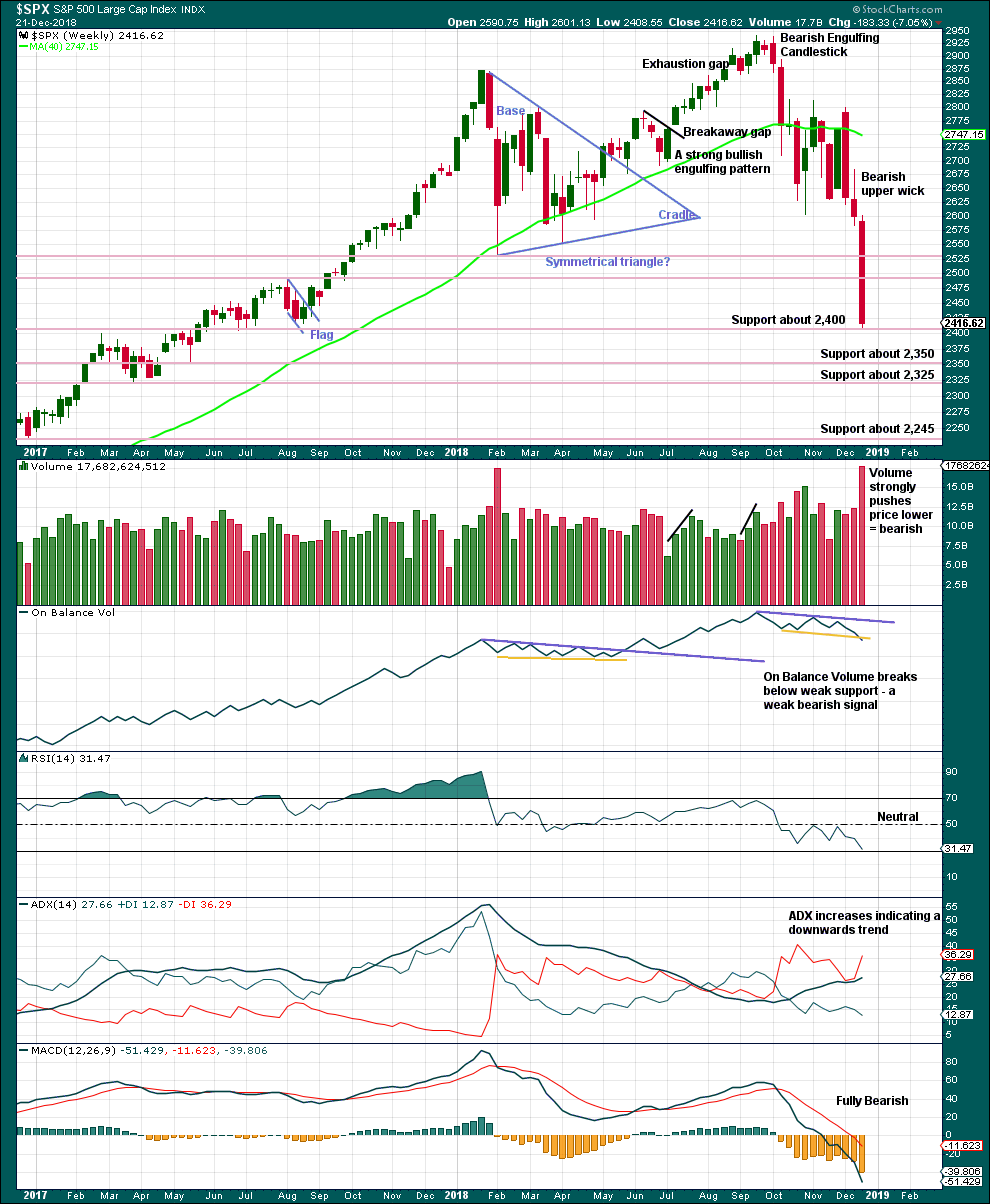
Click chart to enlarge. Chart courtesy of StockCharts.com.
Price has fallen so far 18% from the last all time high.
This last weekly candlestick is very strong indeed. With price closing very close to the low for the week, it looks like more downwards movement may follow next week.
Support lines are identified now on the weekly chart.
This chart is fully bearish.
DAILY CHART
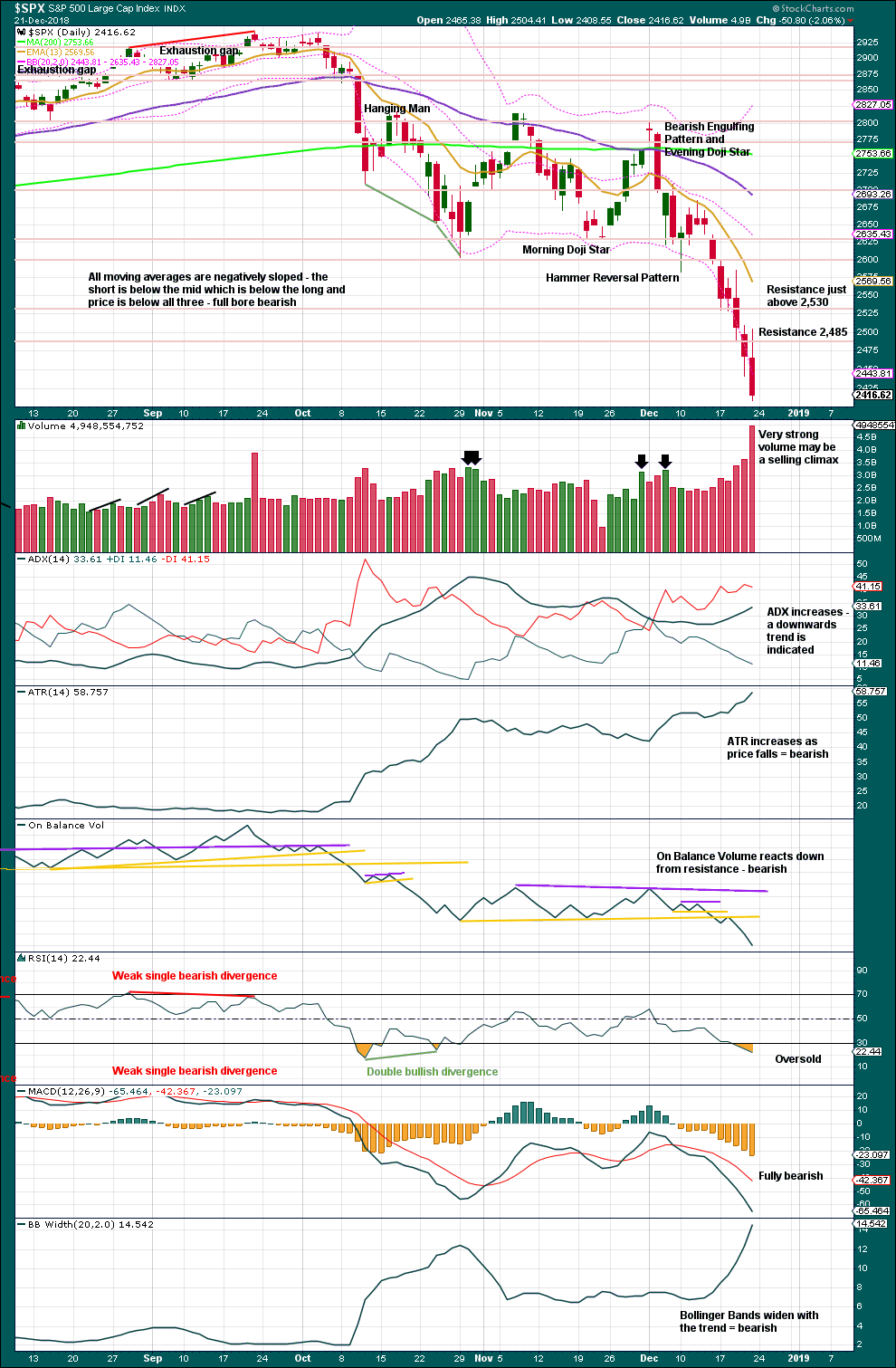
Click chart to enlarge. Chart courtesy of StockCharts.com.
Selling climaxes usually occur close to lows, not at final lows.
Look for a candlestick reversal pattern and / or clear and strong divergence between price and RSI to indicate a potential low. That is not the case today.
This chart remains fully bearish.
BREADTH – AD LINE
WEEKLY CHART
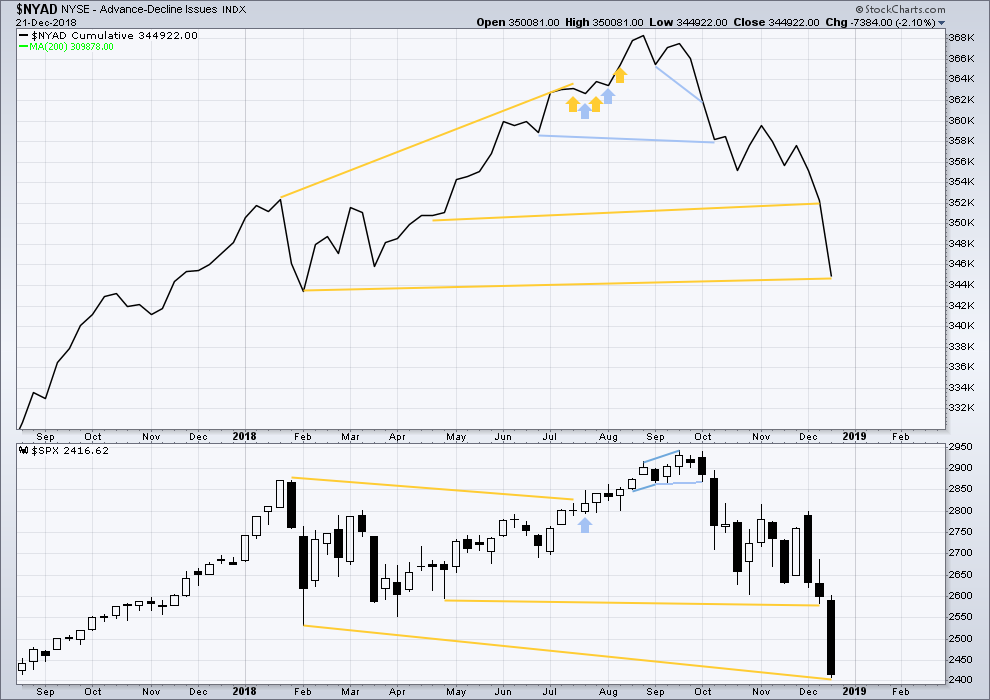
Click chart to enlarge. Chart courtesy of StockCharts.com. So that colour blind members are included, bearish signals
will be noted with blue and bullish signals with yellow.
While price is falling fast, the AD line is not making corresponding new lows. There remains mid-term bullish divergence between price and market breadth.
DAILY CHART
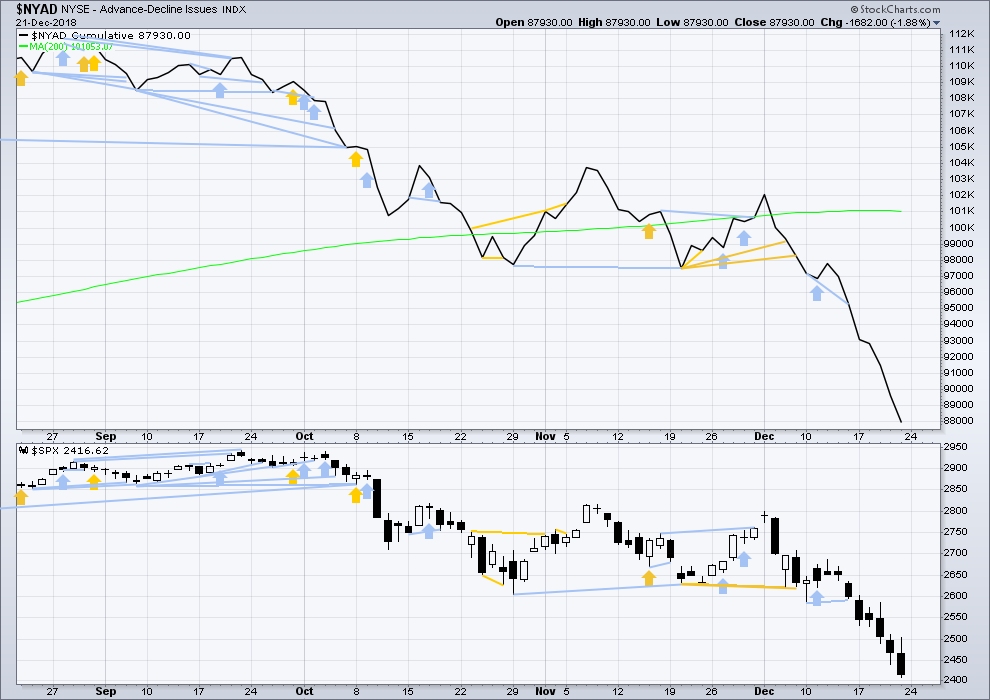
Click chart to enlarge. Chart courtesy of StockCharts.com. So that colour blind members are included, bearish signals
will be noted with blue and bullish signals with yellow.
Breadth should be read as a leading indicator.
Today both price and the AD line have made new lows. There is no divergence.
SUPPLEMENTAL – AD LINE RECENT HISTORY
This exercise looks at how the AD line behaves prior to a fully fledged bear market and compares that to how it behaves prior to a large pullback within a bull market.
There have been three major pullbacks within the current bull market beginning March 2009:

Click chart to enlarge. Chart courtesy of StockCharts.com. So that colour blind members are included, bearish signals
will be noted with blue and bullish signals with yellow.
The first major pullback from 26th April 2010 to 1st July 2010 saw price fall 17% of market value over 47 sessions.
There was only one day of bearish divergence between price and the AD line at the high on 26th April 2010.
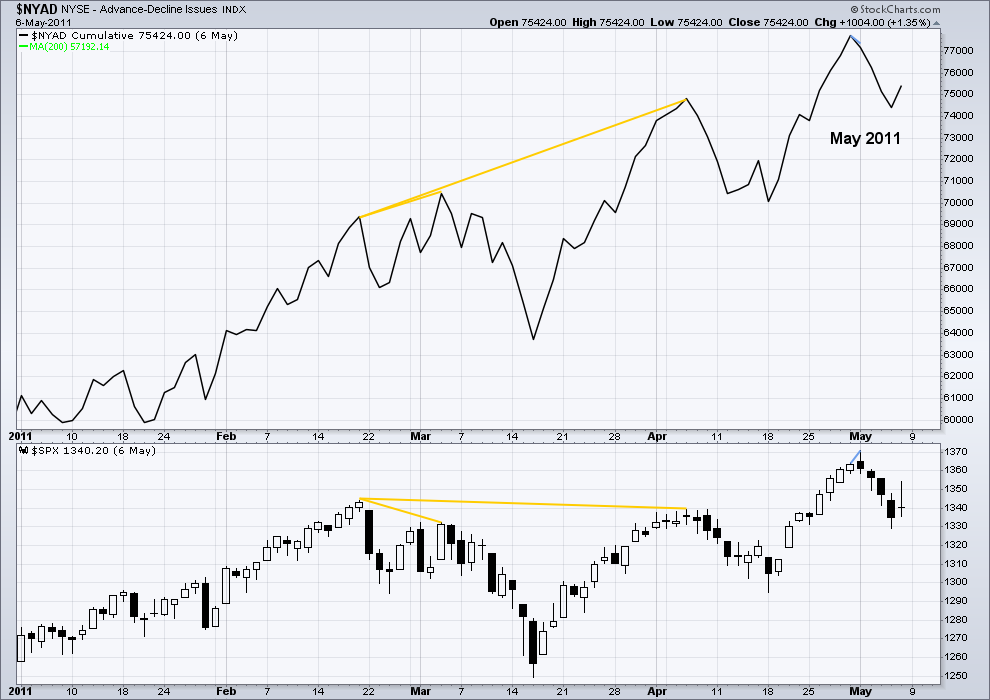
Click chart to enlarge. Chart courtesy of StockCharts.com. So that colour blind members are included, bearish signals
will be noted with blue and bullish signals with yellow.
The next major pullback from 2nd May 2011 to 4th October 2011 saw price fall 22% of market value over 108 sessions.
There was only one day of bearish divergence between price and the AD line at the high on 2011.
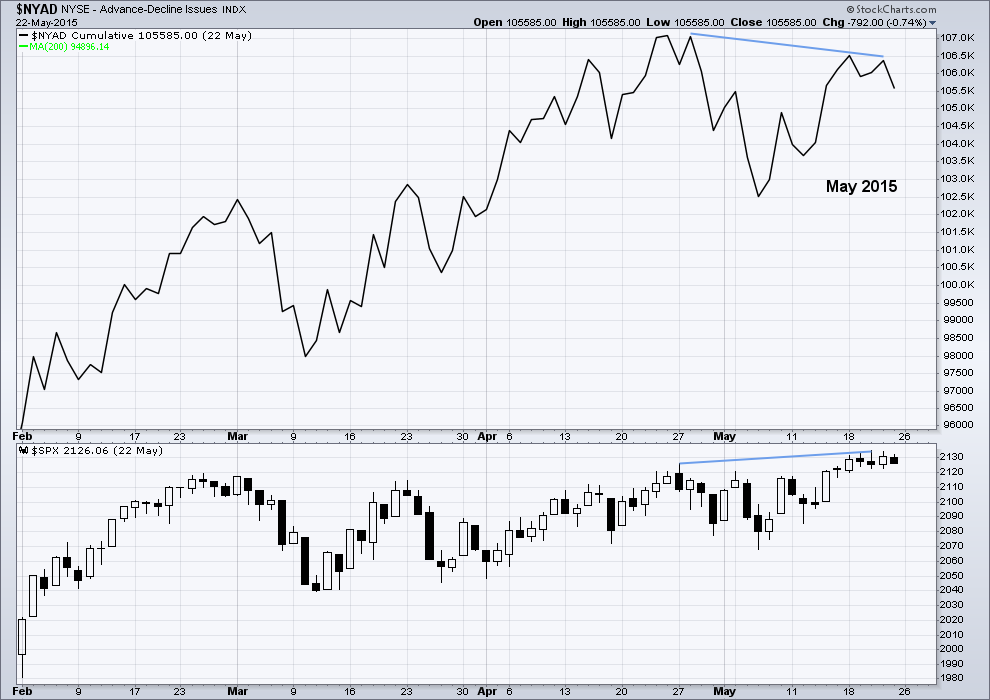
Click chart to enlarge. Chart courtesy of StockCharts.com. So that colour blind members are included, bearish signals
will be noted with blue and bullish signals with yellow.
The third major pullback from 20th May 2015 to 11th February 2016 saw price fall 15% of market value over 184 sessions.
There was only 16 sessions of bearish divergence between price and the AD line at the high on 20th May 2015.
These pullbacks will be compared to the two most recent bear markets beginning March 2000 and October 2007:
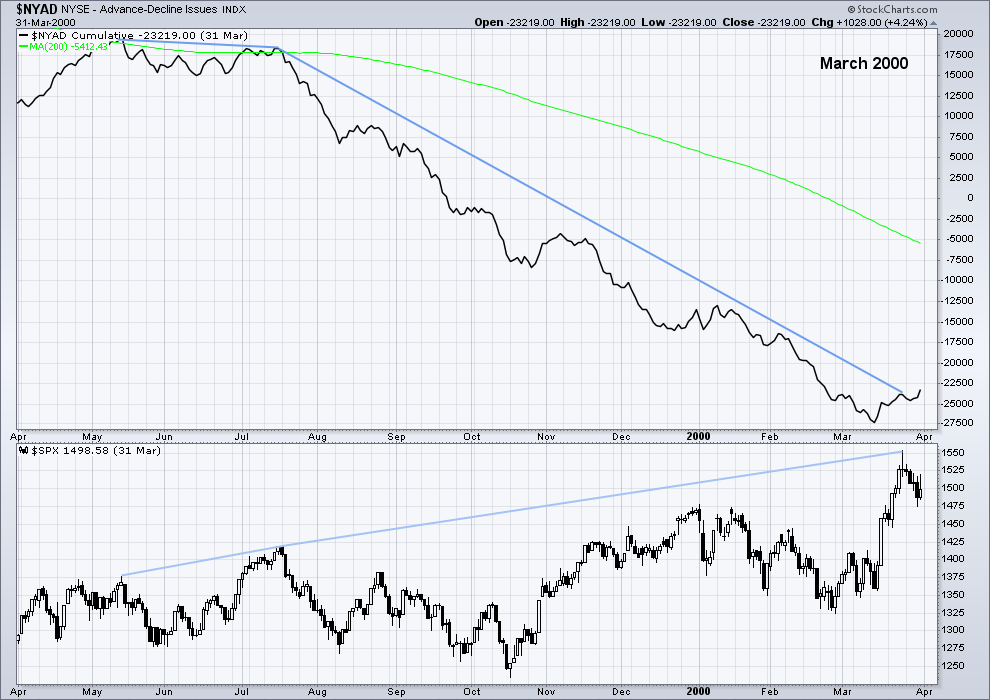
Click chart to enlarge. Chart courtesy of StockCharts.com. So that colour blind members are included, bearish signals
will be noted with blue and bullish signals with yellow.
At the end of the bull market on 24th March 2000, there was bearish divergence between price and the AD line dating back to the 13th May 1999. This divergence is just short of one year in duration.

Click chart to enlarge. Chart courtesy of StockCharts.com. So that colour blind members are included, bearish signals
will be noted with blue and bullish signals with yellow.
At the end of the bull market on 11th October 2007, there was bearish divergence between price and the AD line dating back to 4th June 2007. This was just over 4 months of divergence.
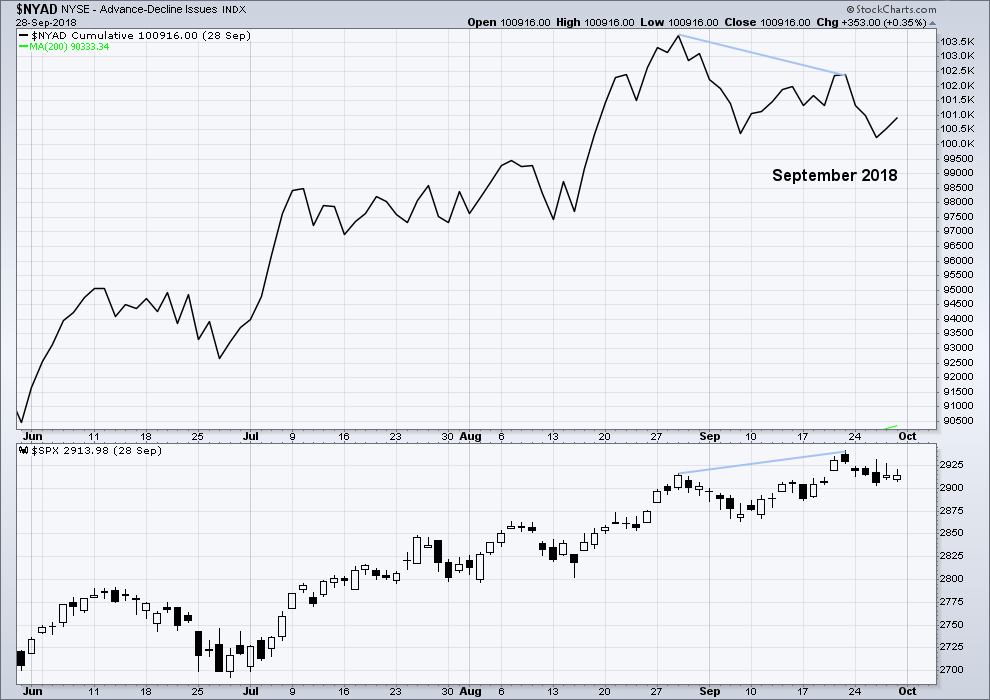
Click chart to enlarge. Chart courtesy of StockCharts.com. So that colour blind members are included, bearish signals
will be noted with blue and bullish signals with yellow.
Finally, a comparison may be made to the current situation.
There was just 16 sessions of bearish divergence between price and the AD line at the last all time high.
This chart is more comparable to the first three charts of pullbacks within a bull market and not to the last two charts of the ends of bull markets and beginning of fully fledged bear markets.
Further, Lowry’s Operating Companies Only AD line shows no divergence between price and breadth at the high of the 21st of September. At that point, there was also no rise in selling pressure as measured by Lowry’s. Normally, selling pressure will show a steady and sustained rise towards the end of a bull market.
In conclusion, I am reasonably confident that the current fall in price will find a low reasonably soon and then be followed by a continuation of the bull market to new all time highs in 2019.
VOLATILITY – INVERTED VIX CHART
WEEKLY CHART

Click chart to enlarge. Chart courtesy of StockCharts.com. So that colour blind members are included, bearish signals
will be noted with blue and bullish signals with yellow.
Bullish divergence noted in last week’s analysis of VIX has disappeared. There is now no divergence as both inverted VIX and price make new lows.
DAILY CHART
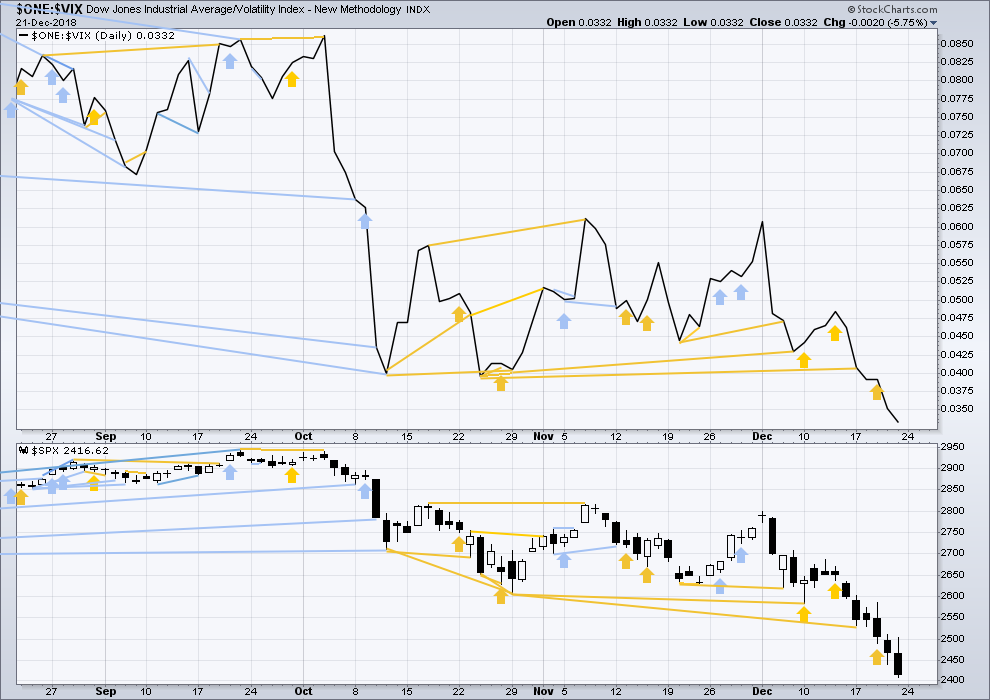
Click chart to enlarge. Chart courtesy of StockCharts.com. So that colour blind members are included, bearish signals
will be noted with blue and bullish signals with yellow.
Both price and inverted VIX have now made new lows following bullish divergence. This divergence is considered to have failed.
SUPPLEMENT – DAILY CHART – OCTOBER 2007 TO MARCH 2009
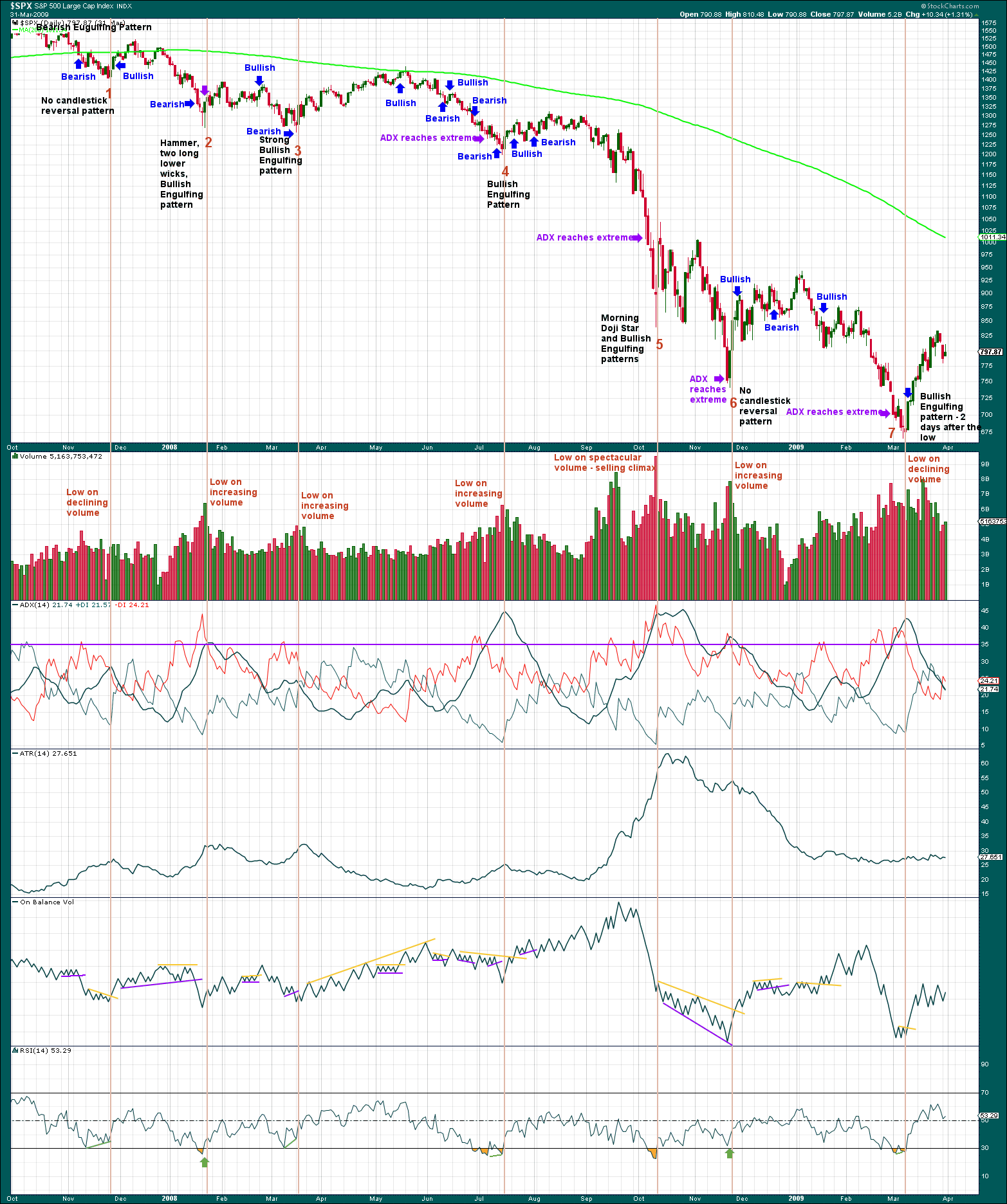
Click chart to enlarge. Chart courtesy of StockCharts.com
This exercise is to determine if there are any signals or a cluster of signals that appeared at minor swing lows and the final low within the most recent bear market from October 2007 to March 2009.
Lows as numbered were characterised by:
1. Declining volume as price fell on the final day, no candlestick reversal pattern, ADX was not extreme. Strong double divergence between price and RSI, but RSI had not reached oversold. A bullish signal from On Balance Volume two days after the low.
2. The day before the low a Hammer pattern (almost a Dragonfly doji but the upper wick is a little too apparent) appeared. The next day a low was found and a Bullish Engulfing pattern completed. Volume increased steadily and markedly to the low. ADX reached extreme just on the day of the low. RSI reached oversold and on the day of the low showed single day bullish divergence.
3. A strong bullish candlestick reversal pattern, and strong divergence with RSI but RSI was not extreme. On Balance Volume gave a bearish signal the day before the low.
4. A candlestick reversal pattern, a strong and steady increase in volume, downwards movement for six sessions after ADX reached very extreme. RSI reached oversold and then exhibited clear divergence with price. On Balance Volume gave a bearish signal two days before the low.
5. A strong bullish candlestick reversal pattern, a spectacular selling climax, ADX reached extreme four sessions prior to the low. RSI reached extreme but exhibited no divergence with price.
6. No candlestick reversal pattern, ADX reached extreme one session before the low, downwards movement had strong support from increasing volume; at the day of the low, there was single day divergence between price and RSI but RSI was not oversold.
7. There was no candlestick reversal pattern (the lower wick was not long enough for a Hammer pattern) at the final low in March 2009. A bullish reversal pattern appeared two sessions after the low. Price fell for the final three sessions on declining volume. ADX reached extreme five sessions prior to the low. On Balance Volume gave a bullish signal two sessions after the low, on the same day as the Bullish Engulfing pattern completed. RSI reached oversold and then exhibited divergence with price.
Additional:
Failed (and partially failed) bearish and bullish candlestick reversal patterns:
14th Feb 2008 – A Bearish Engulfing pattern was followed by only five sessions of downwards movement.
7th May 2008 – A Bearish Engulfing pattern was followed by only two sessions of downwards movement and then a high eight sessions afterwards.
8 Jul 2008 – A Bullish Engulfing pattern was followed by a new low five sessions later.
24th Jul 2008 – A Bearish Engulfing pattern was followed by only two sessions of downwards movement and a new high twelve sessions after.
1 Dec 2008 – A huge Bearish Engulfing pattern was immediately followed by 24 sessions of choppy upwards movement.
20 Feb 2009 – A strong bullish Hammer pattern was followed immediately by downwards movement.
Failed signals from RSI:
3rd Jun 2008 – Price made a slight new swing low and RSI made a slight new swing high. This bullish divergence was slight and RSI was not oversold.
18th Sep 2008 – Single day divergence where price moved lower but RSI moved higher, followed only by one more day of upwards movement.
29th Sep 2008 – Price made a strong new swing low but RSI made a slightly higher swing low, followed by only one day of upwards movement.
3 Oct 2008 – Price made a new low which was not matched by RSI. This bullish divergence was slight and disappeared the following day. It was followed by very strong downwards movement.
13 Nov 2008 – Price made a strong new swing low but RSI was substantially higher. This was followed immediately by very strong downwards movement.
17 Feb 2009 – Price made a new swing low which was not matched by RSI. This bullish divergence disappeared three sessions later and was followed by the final low 13 sessions after.
Volume profile:
Without looking at the price chart, and only looking at volume bars, it is possible to see in what direction price was moving for most of this bear market with a few exceptions. As price moved higher, upwards days exhibited stronger volume than downwards days. The reverse was true as price moved lower. A clear exception was from the 8th to the 18th of Sep 2008, and the 13th of Nov 2008.
Conclusions:
No one indicator or method may be used in isolation.
Strongly rising volume can coincide with a minor or major low. This is also observed by Lowry’s.
Divergence between price and RSI is more reliable when RSI is oversold, or when the divergence is strong. However, even strong divergence can simply disappear.
A cluster of bearish indications at one time increases the probability of a low.
DOW THEORY
Dow Theory confirms a bear market. This does not necessarily mean a bear market at Grand Super Cycle degree though; Dow Theory makes no comment on Elliott wave counts. It may equally as likely mean that Primary wave 4 could be deeper and stronger than originally anticipated.
DJIA: 23,344.52 – a close on the 19th of December at 23,284.97 confirms a bear market.
DJT: 9,806.79 – price has closed below this point on the 13th of December.
S&P500: 2,532.69 – a close on the 19th of December at 2,506.96 provides support to a bear market conclusion.
Nasdaq: 6,630.67 – a close on the 19th of December at 6,618.86 provides support to a bear market conclusion.
GOLD
A small inside day for Friday leaves the Elliott wave count unchanged. The target remains the same.
Summary: The next target is 1,295. Look out for a possible further increase in upwards momentum towards this target. A relatively small blow off top may occur in coming days.
The final target for this bounce to end is about 1,305 – 1,310.
Grand SuperCycle analysis is here.
Last historic analysis with monthly charts is here.
Only three remaining wave counts have a reasonable probability and are published below: a triangle (the preferred wave count), a double zigzag, and a combination.
MAIN ELLIOTT WAVE COUNT
WEEKLY CHART – TRIANGLE
Cycle wave b may be an incomplete regular contracting triangle. Primary wave E may not move beyond the end of primary wave C above 1,365.68.
Within primary wave E, intermediate waves (A) and (B) may be complete. Intermediate wave (C) must subdivide as a five wave structure. Within intermediate wave (C), minor wave 2 may not move beyond the start of minor wave 1 below 1,181.06.
Four of the five sub-waves of a triangle must be zigzags, with only one sub-wave allowed to be a multiple zigzag. Wave C is the most common sub-wave to subdivide as a multiple, and this is how primary wave C for this example fits best. Primary wave E would most likely be a single zigzag. It is also possible that it may subdivide as a triangle to create a rare nine wave triangle.
There are no problems in terms of subdivisions or rare structures for this wave count. It has an excellent fit and so far a typical look.
When primary wave E is a complete three wave structure, then this wave count would expect a cycle degree trend change. Cycle wave c would most likely make new lows below the end of cycle wave a at 1,046.27 to avoid a truncation.
It is possible now that primary wave E may end early in January 2019. Some reasonable weakness should be expected at its end. Triangles often end with declining ATR, weak momentum and weak volume.
DAILY CHART – TRIANGLE
Primary wave E may now be nearing its final stages for this wave count.
Primary wave E should subdivide as a zigzag. Intermediate waves (A) and (B) may now be complete. Intermediate wave (C) may be underway.
Within intermediate wave (C), minor wave 1 fits perfectly as a five wave impulse. Minor wave 2 is a deep zigzag.
Minor wave 3 may be an almost complete impulse, now within the final fifth wave. The target is now calculated at two degrees and so has a higher probability.
Gold often exhibits swift strong fifth waves. This tendency is especially prevalent in fifth waves to end third wave impulses. Look out for a possible blow off top to end minute wave v of minor wave 3.
Although the triangle for cycle wave b is expected to end with weakness, it is still possible that a smaller blow off top may occur at the end of minor wave 3 just ahead.
Within minute wave v, minuette wave (ii) may not move beyond the start of minuette wave (i) below 1,232.98.
A target for primary wave E is the strong zone of resistance about 1,305 to 1,310. Primary wave E is most likely to subdivide as a zigzag (although it may also subdivide as a triangle to create a rare nine wave triangle). It may last a total Fibonacci 21 or 34 weeks. So far it has lasted 18 weeks. Primary wave E may not move beyond the end of primary wave C above 1,365.68.
WEEKLY CHART – DOUBLE ZIGZAG
It is possible that cycle wave b may be a double zigzag or a double combination.
The first zigzag in the double is labelled primary wave W. This has a good fit.
The double may be joined by a corrective structure in the opposite direction, a triangle labelled primary wave X. The triangle would be about three quarters complete.
Within the triangle of primary wave X, intermediate wave (C) should be complete. Within intermediate wave (D), minor waves A and B may be complete. Minor wave C must subdivide as a five wave structure. Within minor wave C, minute wave ii may not move beyond the start of minute wave i below 1,181.06.
Intermediate wave (D) would most likely subdivide as a single zigzag.
This wave count may now expect choppy overlapping movement in an ever decreasing range for several more months.
Primary wave Y would most likely be a zigzag because primary wave X would be shallow; double zigzags normally have relatively shallow X waves.
Primary wave Y may also be a flat correction if cycle wave b is a double combination, but combinations normally have deep X waves. This would be less likely.
This wave count has good proportions and no problems in terms of subdivisions.
WEEKLY CHART – COMBINATION
If cycle wave b is a combination, then the first structure in a double may be a complete zigzag labelled primary wave W.
The double may be joined by a three in the opposite direction, a zigzag labelled primary wave X.
The second structure in the double may be a flat correction labelled primary wave Y. My research on Gold so far has found that the most common two structures in a double combination are one zigzag and one flat correction. I have found only one instance where a triangle unfolded for wave Y. The most likely structure for wave Y would be a flat correction by a very wide margin, so that is what this wave count shall expect.
Within a flat correction for primary wave Y, the current downwards wave of intermediate wave (B) may be a double zigzag. Intermediate wave (B) must retrace a minimum 0.9 length of intermediate wave (A) at 1,147.34. Intermediate wave (B) may move beyond the start of intermediate wave (A) as in an expanded flat.
No upper invalidation point is given on this chart. Minor wave X may still continue higher. There is no Elliott wave rule stating a minimum nor maximum length for X waves within multiples.
Because the minimum requirement for intermediate wave (B) is not yet met, this wave count requires that intermediate wave (B) continues lower. This is the most immediately bearish of all weekly wave counts.
When intermediate wave (B) is complete, then intermediate wave (C) would be expected to make at least a slight new high above the end of intermediate wave (A) at 1,365.68 to avoid a truncation. Primary wave Y would be most likely to end about the same level as primary wave W at 1,374.91, so that the whole structure takes up time and moves price sideways, as that is the purpose of double combinations.
While double combinations are very common, triples are extremely rare. I have found no examples of triple combinations for Gold at daily chart time frames or higher back to 1976. When the second structure in a double is complete, then it is extremely likely (almost certain) that the whole correction is over.
Minor wave X now only fits as a possible triple zigzag which could possibly be complete.
While double zigzags are fairly common, triples are reasonably rare. I have found four examples at the daily chart level or higher for Gold back to 1976.
However, X waves within multiple zigzags (which is the structure seen here for intermediate wave (B) ) are very rarely themselves multiples.
The probability of this wave count is substantially reduced. It no longer warrants a daily chart.
TECHNICAL ANALYSIS
WEEKLY CHART
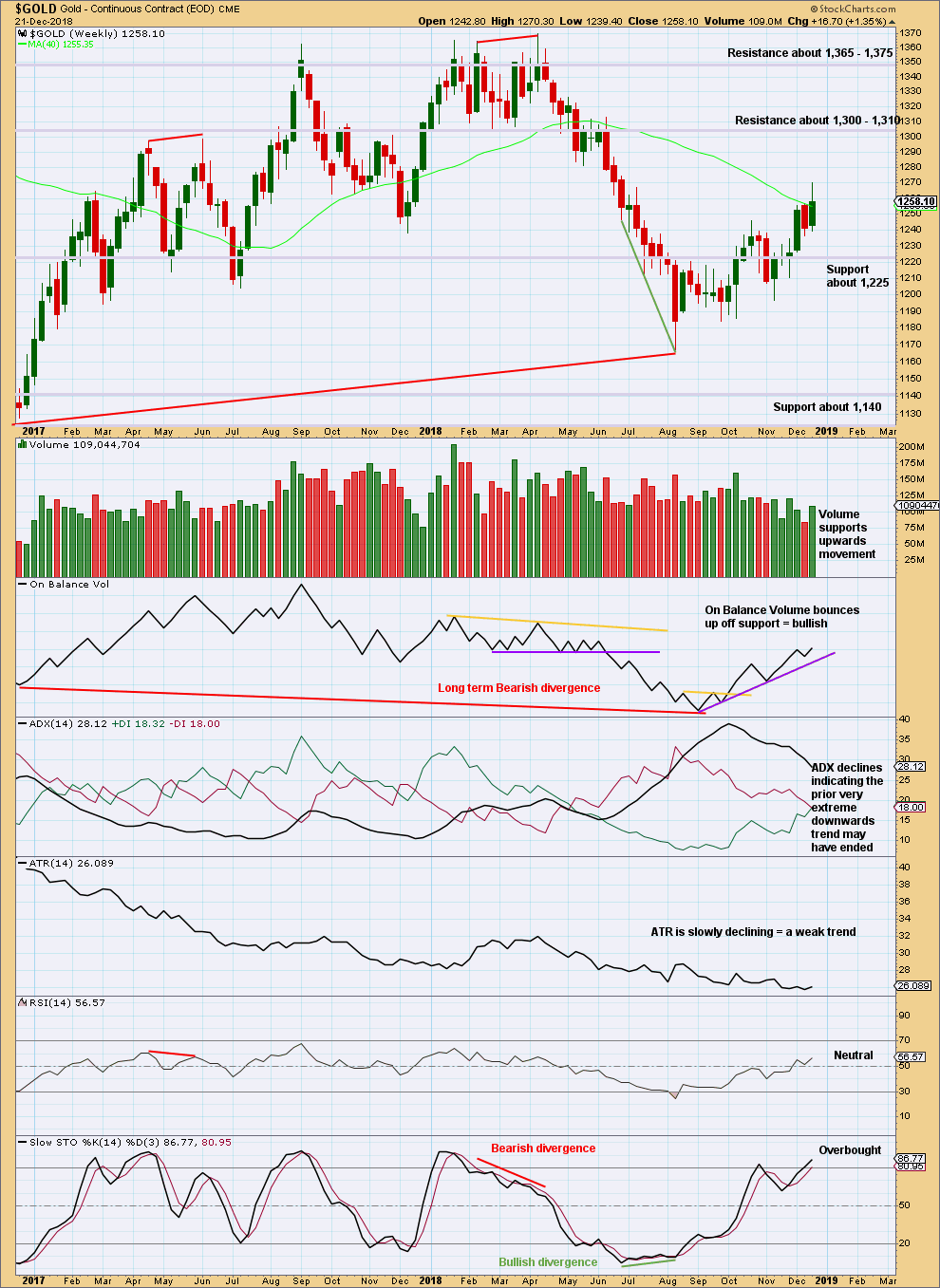
Click chart to enlarge. Chart courtesy of StockCharts.com.
On Balance Volume has made a lower low than its prior low at the end of November 2015. This divergence is extremely bearish but does not rule out a consolidation unfolding here; the divergence does strongly support the Triangle wave count, which expects a consolidation or bounce up to test resistance now and then a continuation of a major bear market. It could also support the flat wave count that allows for a new low below 1,046.27 in coming months.
Volume this week suggests more upwards movement ahead. The slightly long upper wick warns a small pullback may unfold first; it may be complete intra-week.
DAILY CHART
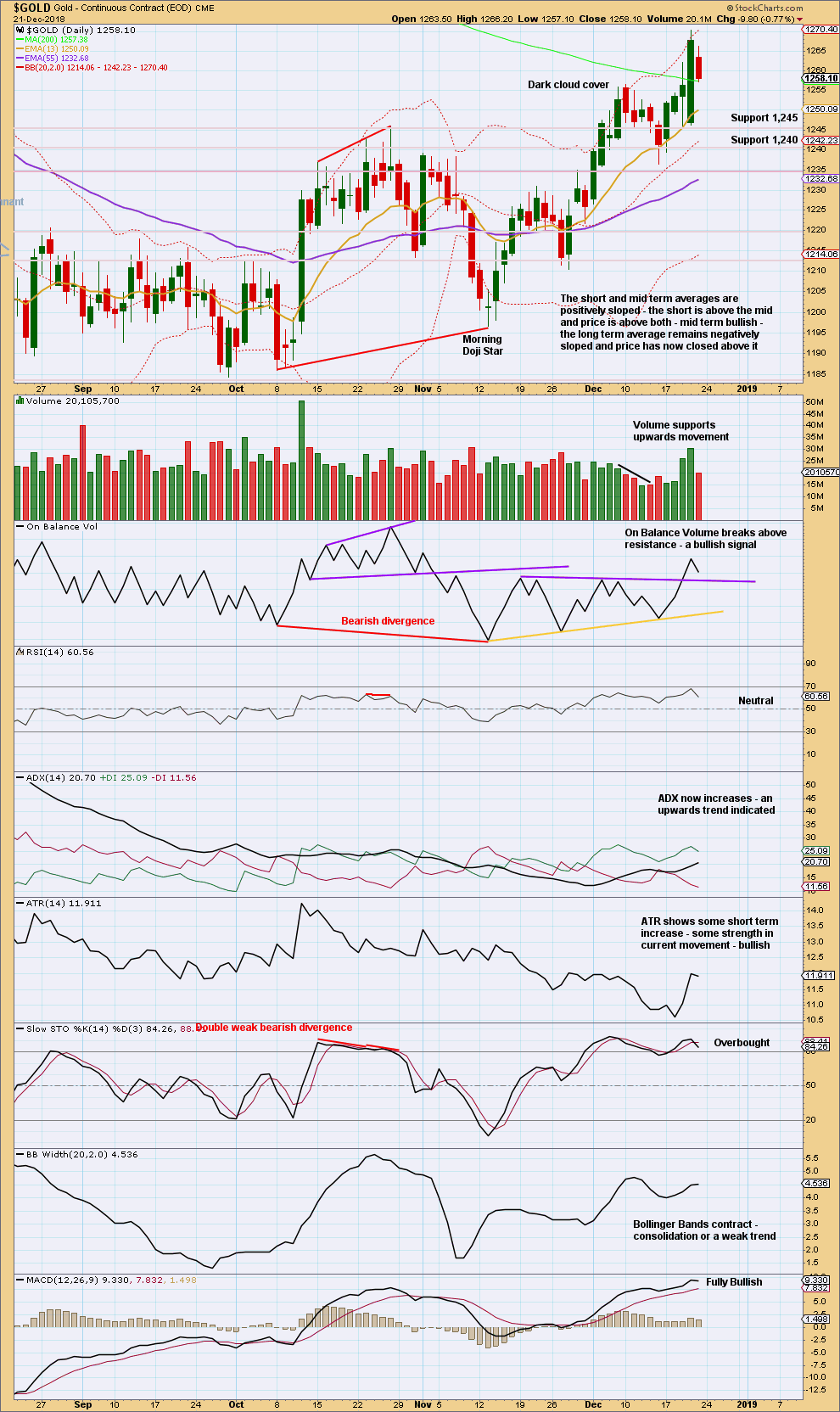
Click chart to enlarge. Chart courtesy of StockCharts.com.
Support on On Balance Volume may assist to force any pullback here to be relatively brief and shallow.
With ADX indicating an upwards trend, Stockcharts at overbought should be ignored. This indicator may remain extreme for long periods of time during a strong trend.
On balance this chart is very bullish.
GDX WEEKLY CHART
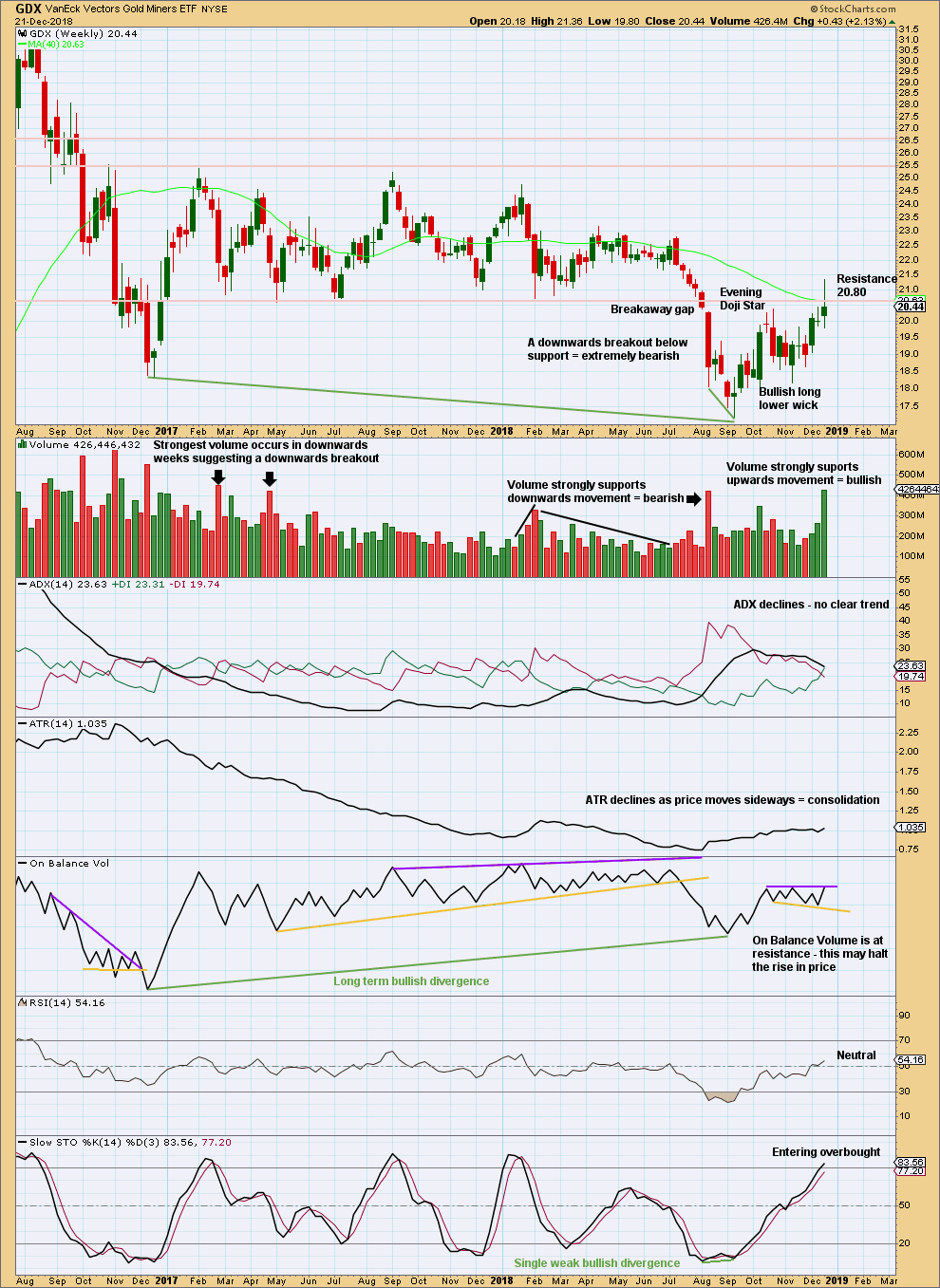
Click chart to enlarge. Chart courtesy of StockCharts.com.
GDX DAILY CHART
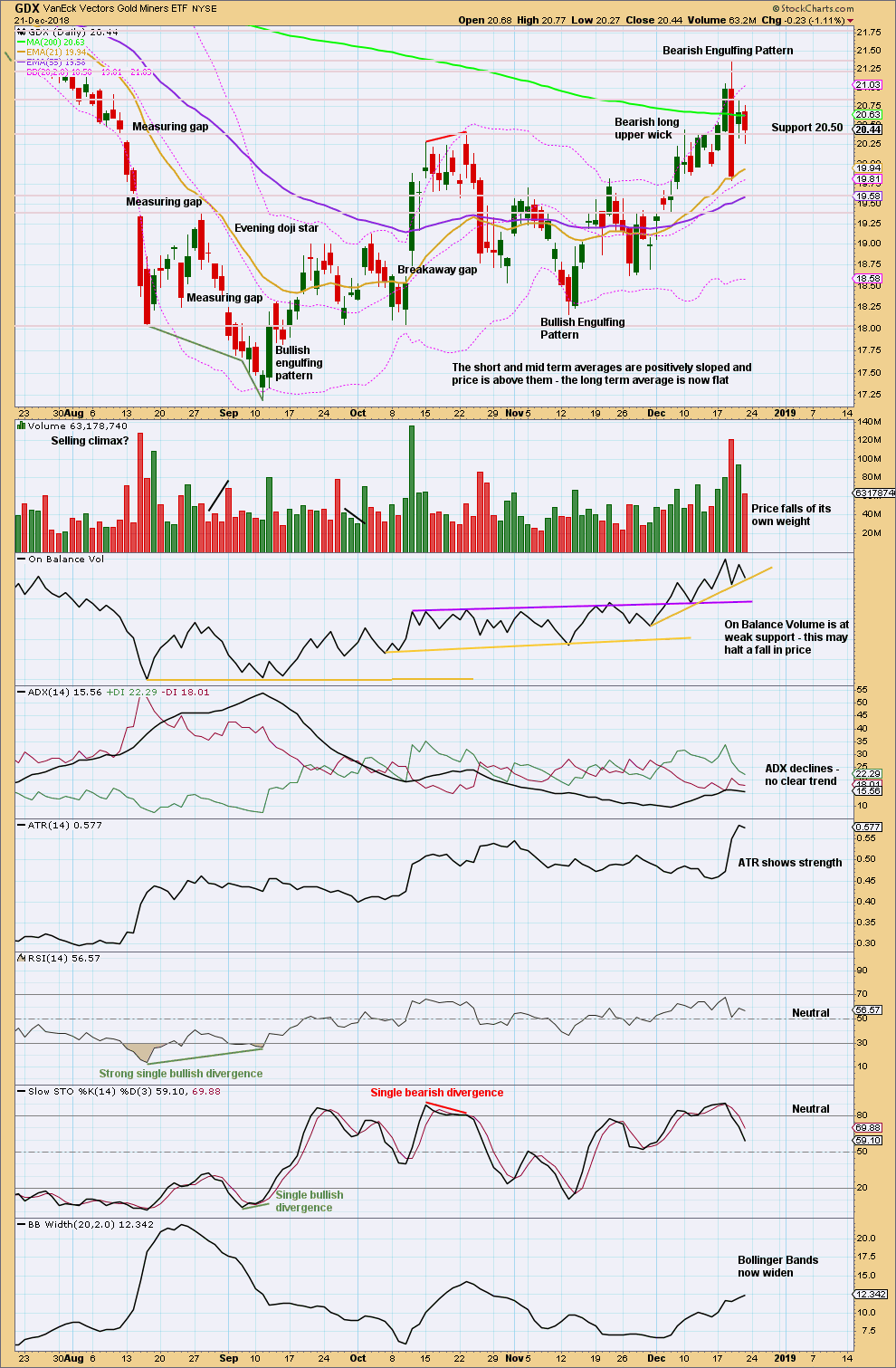
Click chart to enlarge. Chart courtesy of StockCharts.com.
Price has been very strongly rejected just above 20.80.
The very strong Bearish Engulfing reversal pattern indicates the upwards trend is now over. Expect GDX to go on to make new lows below 17.28.
US OIL
An intra-week update gave a new target for more downwards movement. Price has continued to move lower towards the target.
Summary: Intermediate wave (1) has proven to be incomplete. The new target for it to end at is 42.10.
Use the best fit channel on the daily chart. Assume more downwards movement to the target while price remains within this channel. A breach of this channel would indicate the possible end to this first wave down and the beginning of a multi-week bounce or sideways consolidation.
The other thing to look for next week is a bullish candlestick reversal pattern on the daily chart.
This trend is now very extreme and exhibits a beginning weakness. It can continue lower however for a reasonable time. Be aware a low is approaching, but not here yet.
The larger picture still sees Oil in a new downwards trend to end reasonably below 26.06.
MAIN ELLIOTT WAVE COUNT
MONTHLY CHART
Classic technical analysis favours a bearish wave count for Oil at this time.
The large fall in price from the high in June 2008 to February 2016 is seen as a complete three wave structure. This large zigzag may have been only the first zigzag in a deeper double zigzag.
The first zigzag down is labelled cycle wave w. The double is joined by a now complete three in the opposite direction, a zigzag labelled cycle wave x.
The purpose of a second zigzag in a double is to deepen the correction when the first zigzag does not move price deep enough. Cycle wave y would be expected to move reasonably below the end of cycle wave w to deepen the correction. Were cycle wave y to reach equality with cycle wave w that takes Oil into negative price territory, which is not possible. Cycle wave y would reach 0.618 the length of cycle wave w at $2.33.
A better target calculation would be using the Fibonacci ratios between primary waves A and C within cycle wave y. This cannot be done until both primary waves A and B are complete.
Within cycle wave y, no second wave correction nor B wave may move beyond its start above 76.90.
WEEKLY CHART
Cycle wave x is seen as a complete zigzag. Within the zigzag, primary wave C is a five wave impulse and within it intermediate wave 4 is a triangle.
A new low below 51.67 has added confidence in this bearish wave count. At that stage, the bullish alternate was invalidated.
Cycle wave y is expected to subdivide as a zigzag. A zigzag subdivides 5-3-5. Primary wave A must subdivide as a five wave structure if this wave count is correct.
Within primary wave A, intermediate wave (1) may be nearing its end but does not look complete at this stage. When intermediate wave (1) is complete, then intermediate wave (2) may unfold over a few weeks as a sideways choppy consolidation, or a deep sharp bounce.
DAILY CHART
Despite a breach of the narrow channel on last week’s daily chart, price has continued lower this week. The channel is redrawn.
This wave count is supported by MACD. The strongest momentum is the end of the third wave.
Minor wave 5 may exhibit an increase in momentum for a selling climax (behaviour typical of commodities). However, while fifth waves within commodities can be strong, they are not always so. This is a tendency to be aware of, not a certainty.
When the channel is breached by upwards movement, that may be an early indication that intermediate wave (1) may again be complete and intermediate wave (2) may then have begun.
Intermediate wave (2) may be very deep. It should last at least four weeks, so that it shows up on the monthly chart.
Intermediate wave (2) may not move beyond the start of intermediate wave (1) above 76.90.
TECHNICAL ANALYSIS
MONTHLY CHART
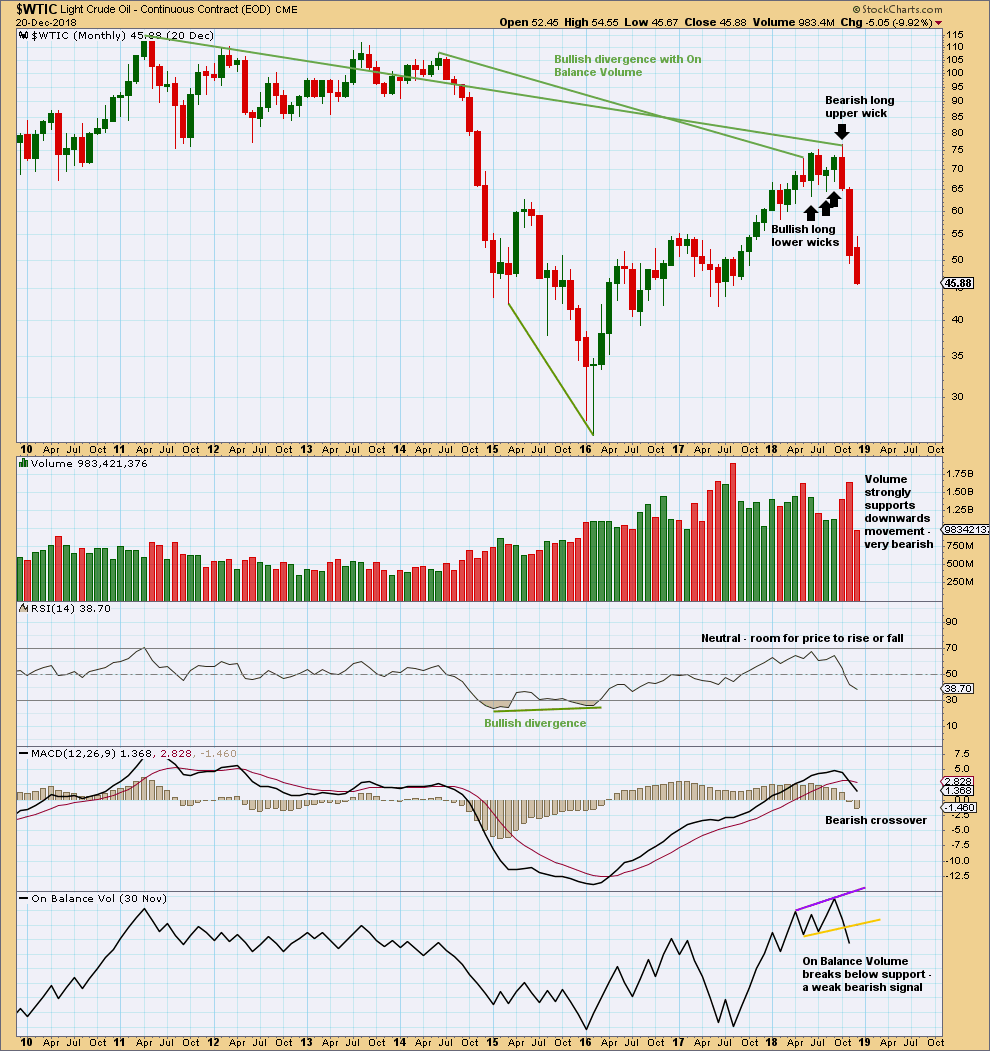
Click chart to enlarge. Chart courtesy of StockCharts.com.
The month of November has a very small lower wick. This is still fairly bearish.
The signal from On Balance Volume is weak because the trend line breached had only two anchor points and a reasonable slope. But it is still a bearish signal.
WEEKLY CHART

Click chart to enlarge. Chart courtesy of StockCharts.com.
This chart supports the Elliott wave count. Oil is within a bearish trend. The trend is not yet extreme.
There is no candlestick reversal pattern and no bullish divergence between price and RSI.
There is room here for price to keep falling.
DAILY CHART
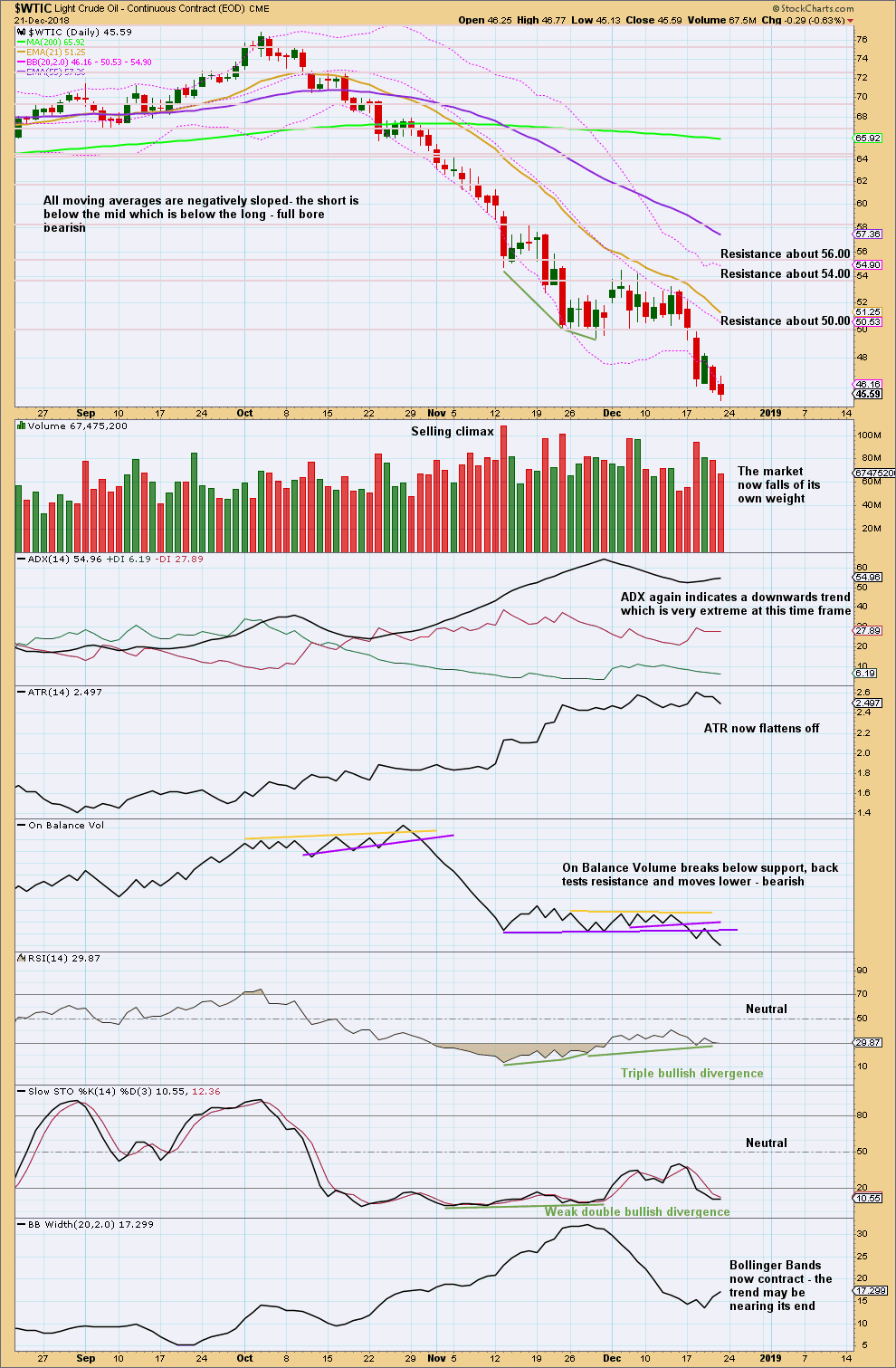
Click chart to enlarge. Chart courtesy of StockCharts.com.
The trend continues and at this time frame is very extreme. Strong and persistent bullish divergence between price and RSI indicates a low may be approaching.
Flattening ATR indicates the trend may be becoming tired.
Look for a bullish candlestick reversal pattern and / or a breach of the trend channel on the daily Elliott wave chart to indicate this trend may be over for the mid term.
—
Always practice good risk management as the most important aspect of trading. Always trade with stops and invest only 1-5% of equity on any one trade. Failure to manage risk is the most common mistake new traders make.

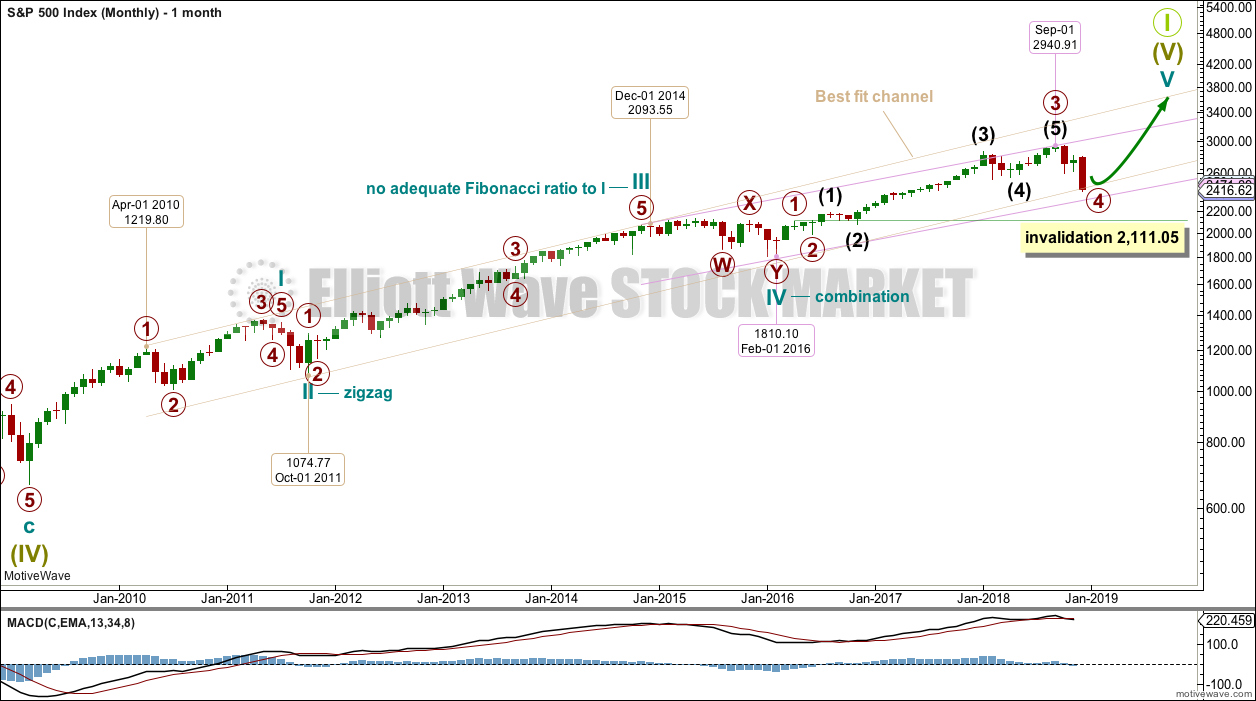
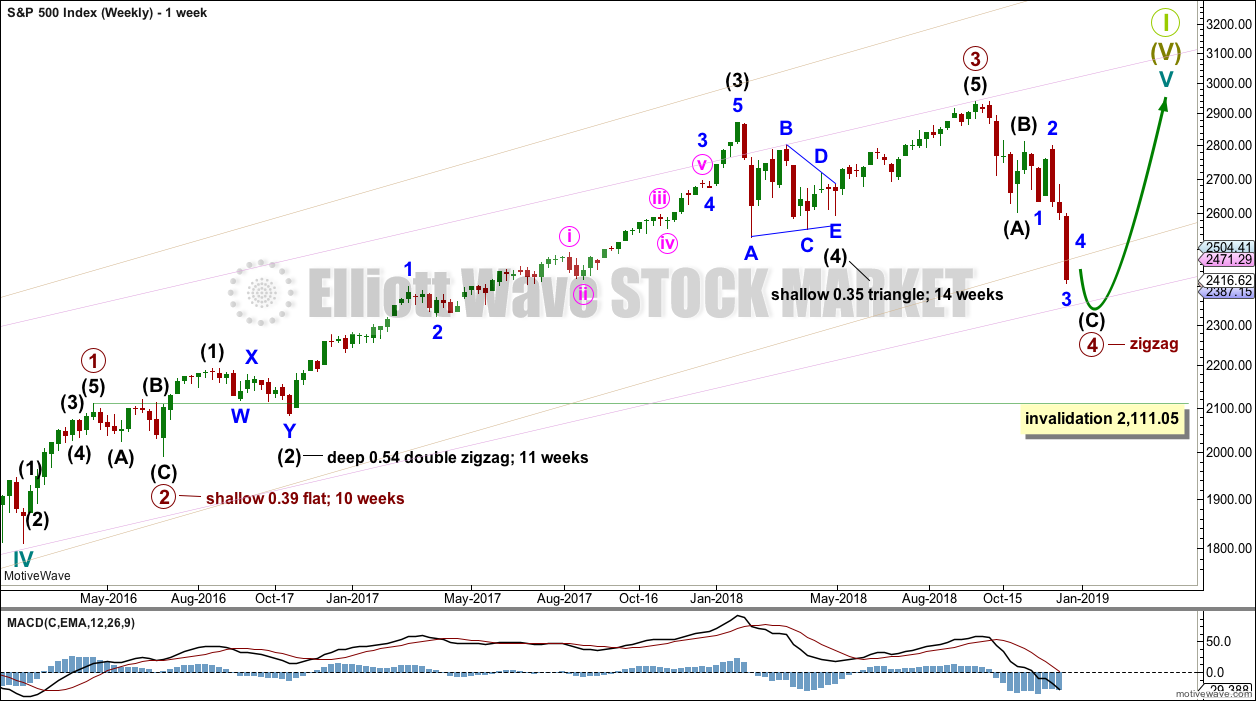
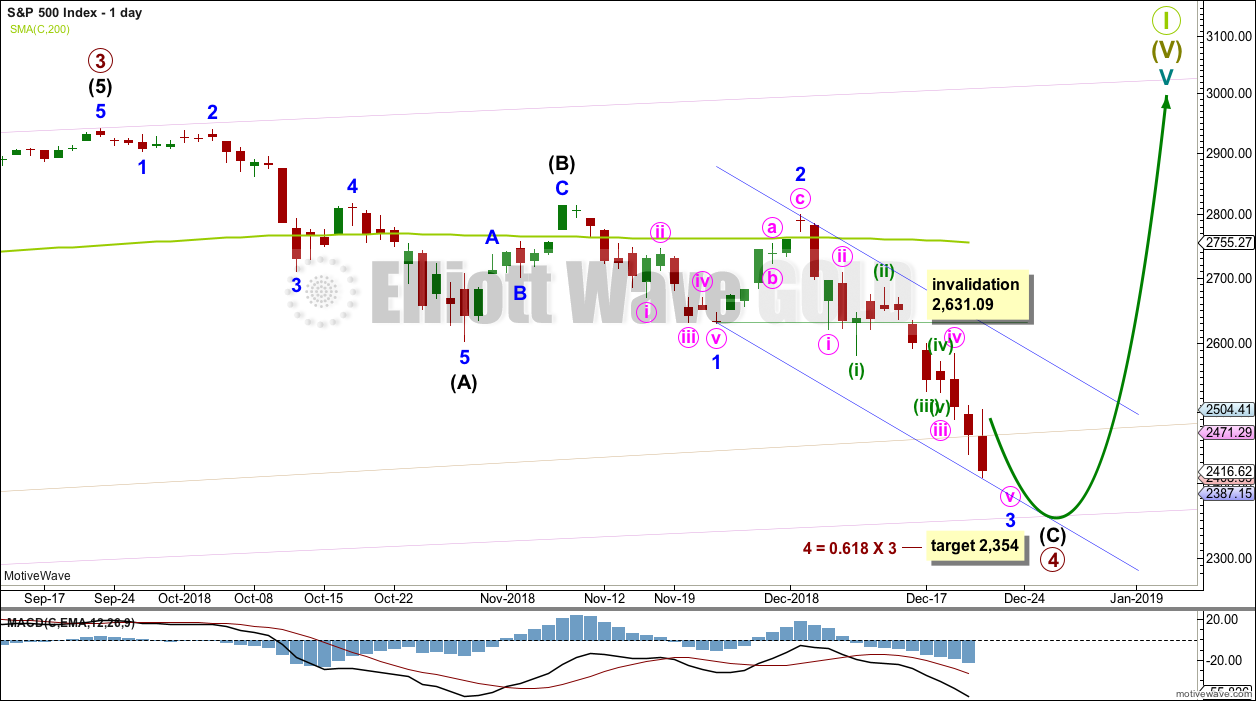
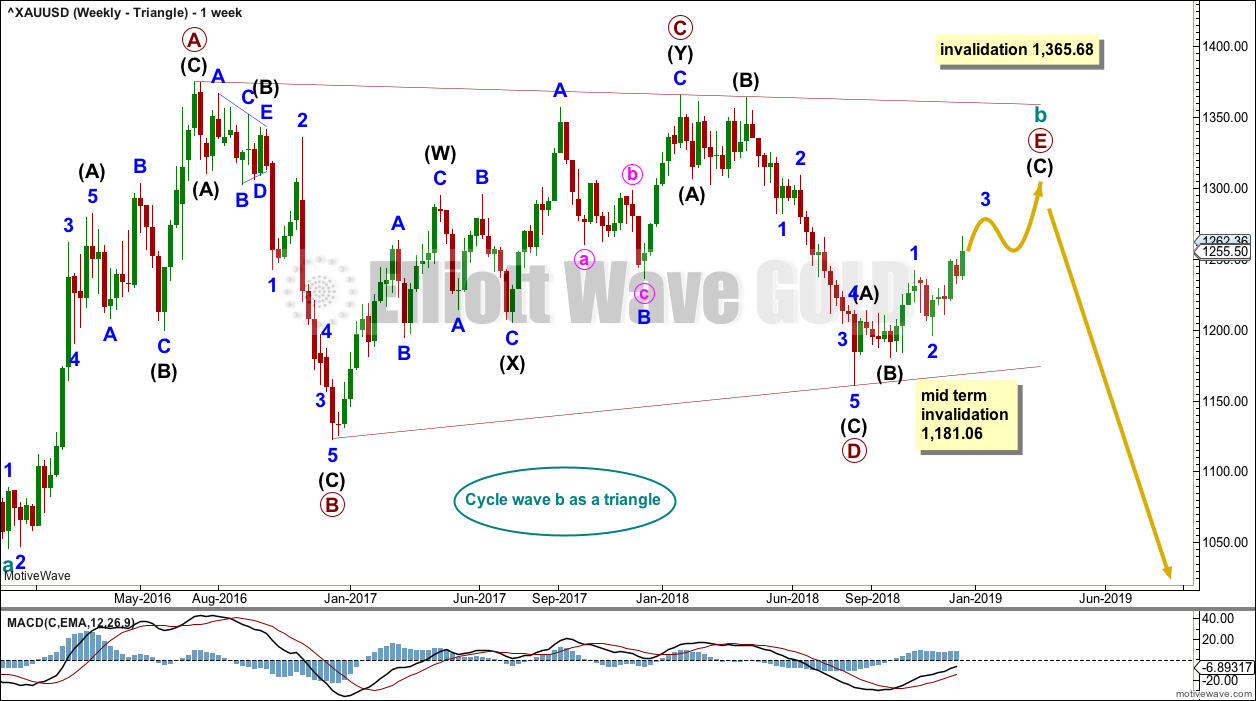
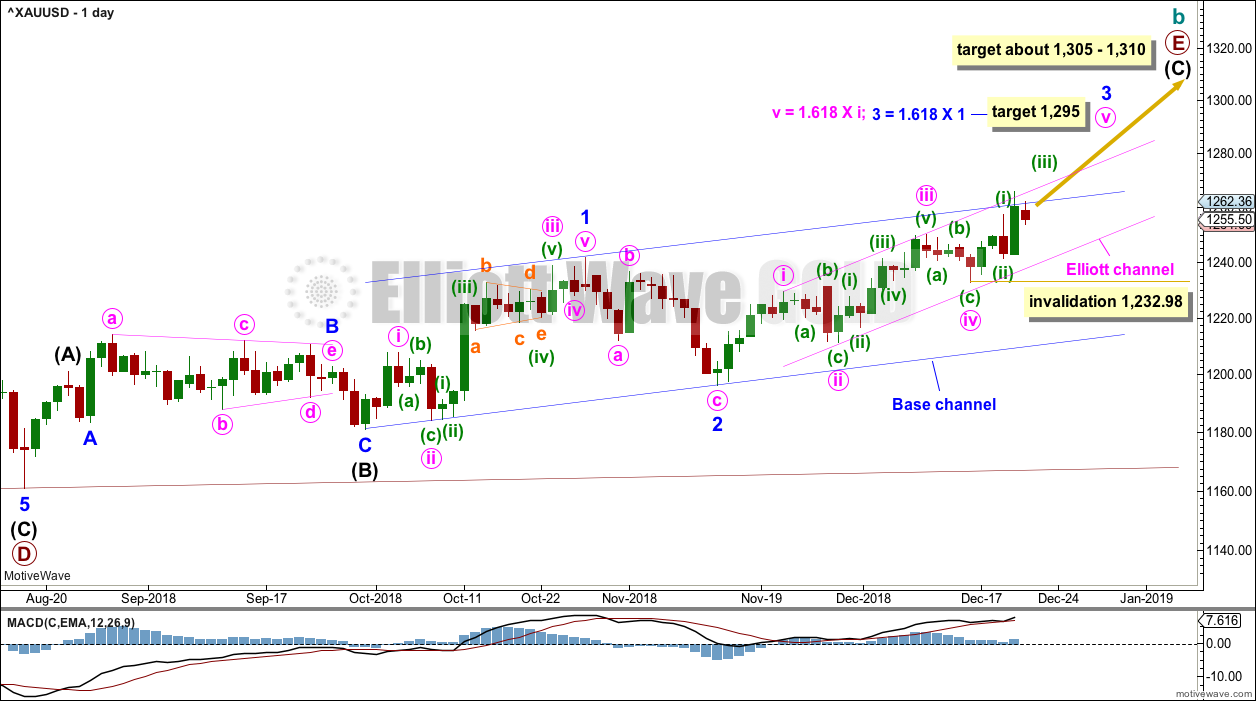
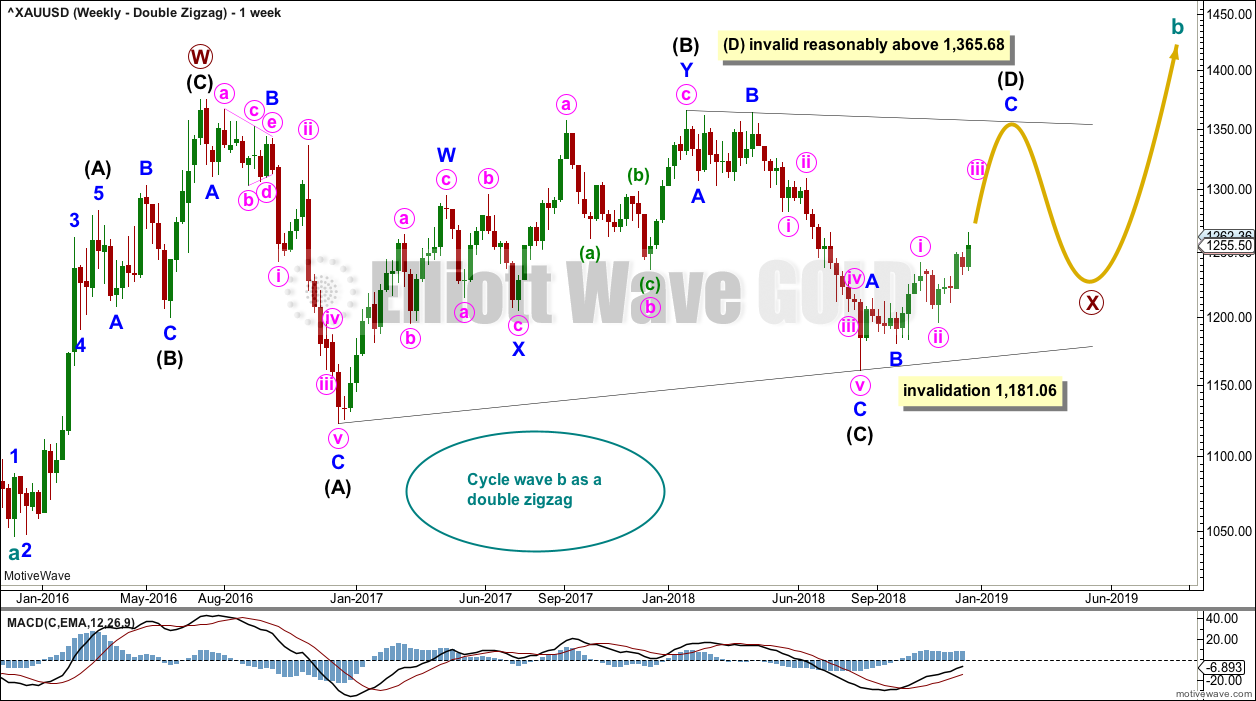
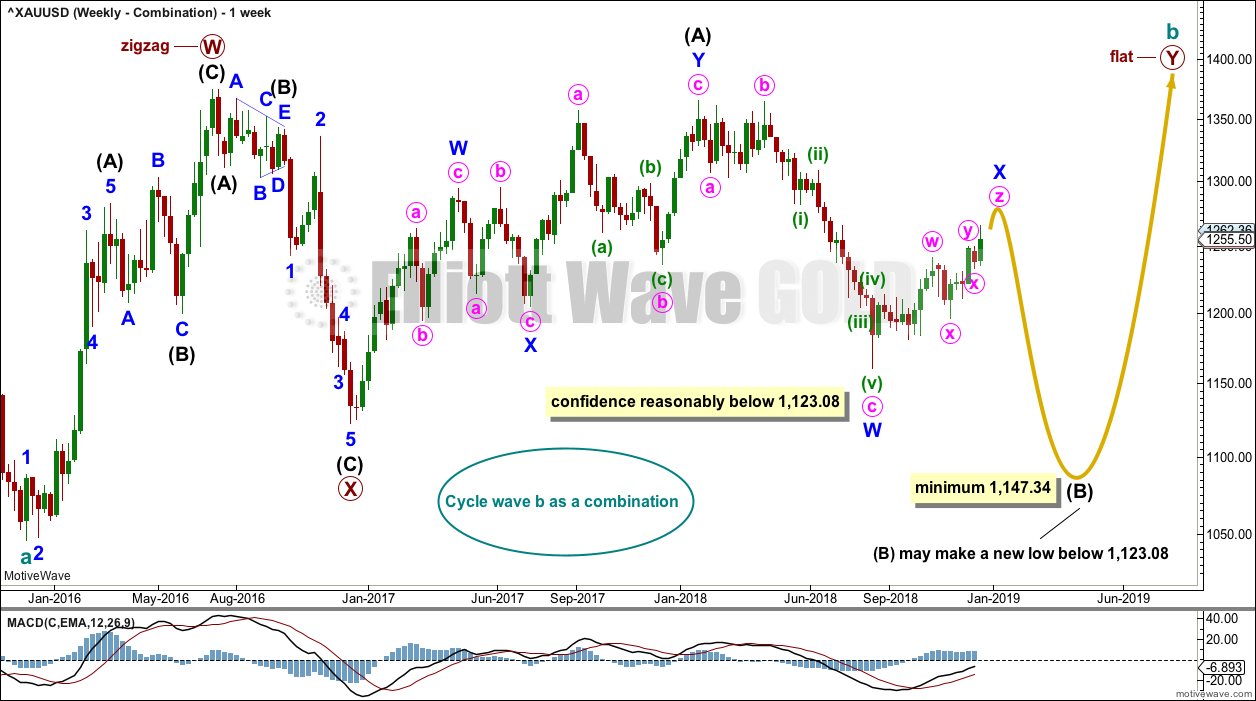

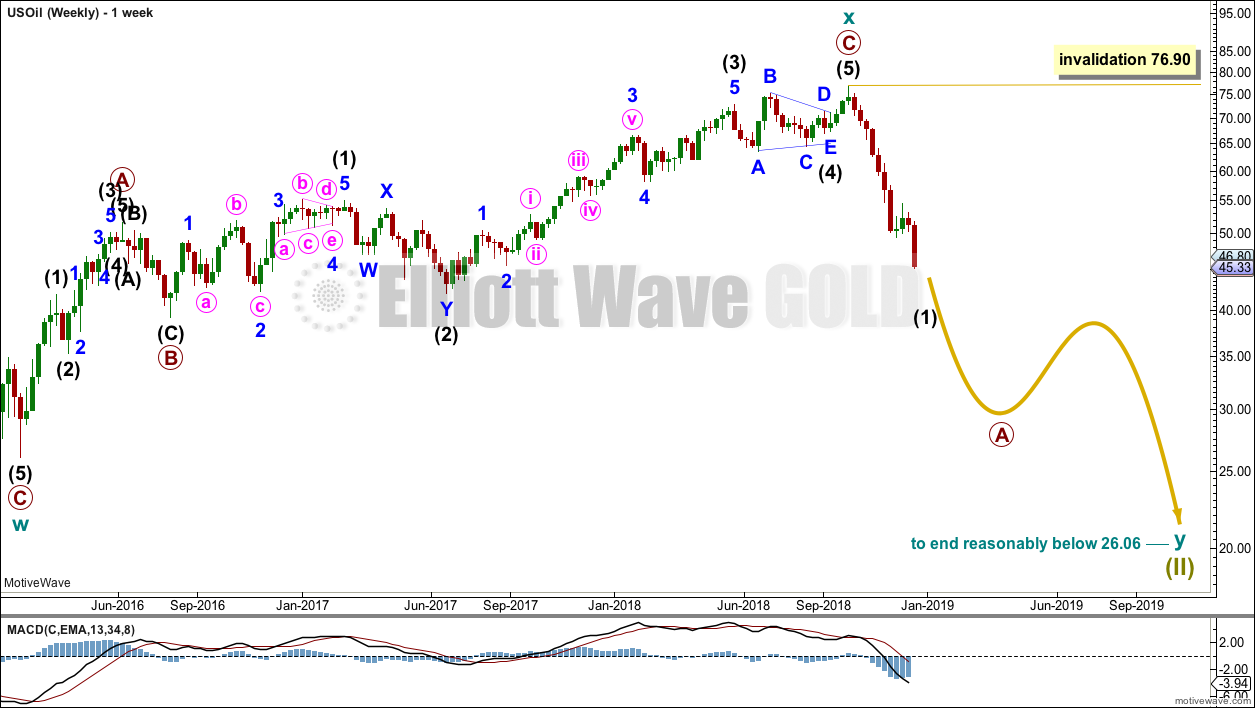
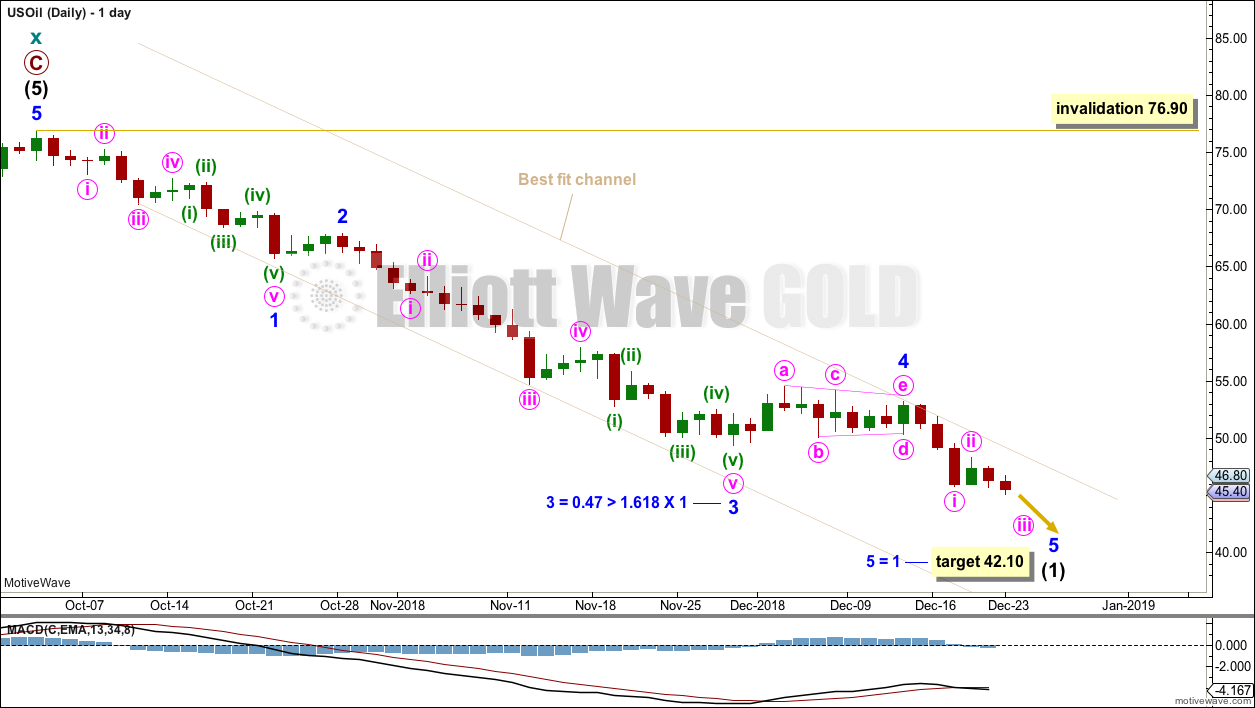
It looks like US Oil has found a low for the short to intermediate term. The candlestick for the 26th is very bullish and has strong support from volume. It’s not properly a Bullish Engulfing pattern because the open is above the close of the prior session, but the close of the 26th is very bullish.
The target for intermediate (2) is the 0.618 Fibonacci ratio of intermediate (1) at 63.70
Many thanks, Lara. A merry and joy filled Christmas to you and your followers thanks for keeping an eye on the markets for us over the new year!
You’re most welcome. And a very Merry Christmas to you too.